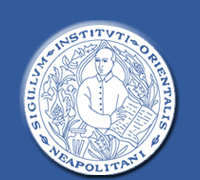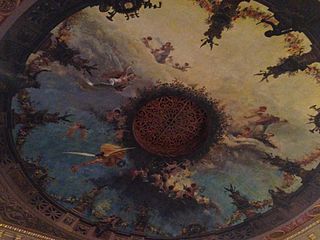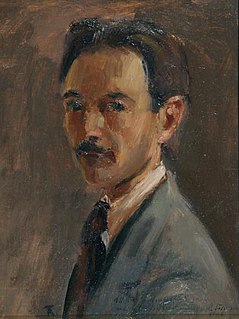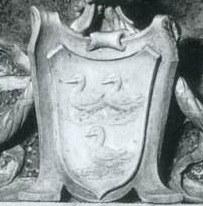Aniello Falcone was an Italian Baroque painter, active in Naples and noted for his painted depictions of battle scenes. Some sources refer to him as Ancillo Falcone.

Gaetano Filangieri was an Italian jurist and philosopher.

Renato Caccioppoli was an Italian mathematician, known for his contributions to mathematical analysis, including the theory of functions of several complex variables, functional analysis, measure theory.

Castel Nuovo, often called Maschio Angioino, is a medieval castle located in front of Piazza Municipio and the city hall in central Naples, Campania, Italy. Its scenic location and imposing size makes the castle, first erected in 1279, one of the main architectural landmarks of the city. It was a royal seat for kings of Naples, Aragon and Spain until 1815.

Paolo de Matteis was an Italian painter.

Fabrizio Santafede or Fabrizio Santaféde was an Italian painter known for his altarpieces. He painted in a late-Mannerist style and his style marks the transition from Mannerism to Baroque.
Giovanni Battista Buonocore was an Italian painter of the Baroque period. He became Rector (1679), then Principe (1698) of the Accademia di San Luca of Rome.
Carlo Moscatiello (1650–1739) was an Italian painter of the Baroque period, active near his natal city of Naples. He was active in quadratura.

University of Naples "L'Orientale", is a university located in Naples, Italy. It was founded in 1732 by Matteo Ripa and is organized in 4 Faculties. It is the oldest school of Sinology and Oriental Studies of the European continent and the main university in Italy specialized in the study of non-European languages and cultures, with research and studies agreements with universities from all over the world. It is one of the most prestigious universities in the world regarding Asian cultures and languages.

Eduardo Dalbono was an Italian painter born in Naples.

Giuseppe Mancinelli was an Italian painter.

The church of Santi Severino e Sossio and the annexed monastery are located on via Bartolommeo Capasso in Naples, Italy.
Santolo Cirillo was an Italian painter, engraver, and stucco artist, active in Naples. He was born in Grumo Nevano, a town near Naples. He contributed frescoes and paintings the Cathedral of San Gennaro, the Basilica of Santa Restituta, and Santa Donna Regina Nuova in Naples. He also painted for the Basilica di San Tammaro in his home town of Grumo Nevano. He frescoed in 1733 a Miracle of San Domenico and a San Pio in Prayer for Santa Caterina a Formiello, painted in the style of Paolo de Matteis.

Carlo Brancaccio was an Italian painter, active mainly in an Impressionist style.

The Caffè Gambrinus is a historic, private cafe or coffeehouse in Central Naples, Italy on via Chiaia. It is located in the rear of the Palazzo della Prefettura, which lies in front and to side of the Royal Palace of Naples, both of which face the Piazza del Plebiscito. The name Gambrinus is a legendary somewhat tipsy figure of joviality, and his name is used for various brands and many establishments.

The Palazzo Zevallos Stigliano is a Baroque palace located on Via Toledo number 185 in the quartiere San Ferdinando of central Naples, Italy. It is also called the Palazzo Zevallos or Palazzo Colonna di Stigliano, and since 2014 serves as a museum of artworks, mainly spanning the 17th through the early 20th centuries, sponsored by the Cultural Project of the bank Intesa Sanpaolo. This museum is linked to the Museum or Gallerie di Piazza Scala in Milan and the Museum at Palazzo Leoni Montanari in Vicenza, also owned by the Bank.
Renato Barisani was an Italian sculptor and painter.

Ferdinand van den Eynde, 1st Marquess of Castelnuovo was an Italian nobleman and magnate of Flemish descent. He was the son of Jan van den Eynde, and the father of Elisabeth van den Eynde, Princess of Belvedere and Baroness of Gallicchio and Missanello and Jane (Giovanna) van den Eynde, Princess of Galatro and Sonnino. He should not be confused with his namesake and uncle Ferdinand van den Eynde.

Elisabeth van den Eynde, Princess of Belvedere and suo jure Baroness of Gallicchio and Missanello was an Italian noblewoman. She was the consort of Carlo Carafa, 3rd Prince of Belvedere, 6th Marquess of Anzi, and Lord of Trivigno, and the daughter of Ferdinand van den Eynde, 1st Marquess of Castelnuovo and Olimpia Piccolomini, of the House of Piccolomini. Her grandfather was Jan van den Eynde, a wealthy Flemish merchant, banker and art collector who purchased and renovated the Palazzo Zevallos Stigliano in 1653. Her father Ferdinand, the Marquess of Castelnuovo, built the Vandeneynden Palace of Belvedere between 1671 and 1673. While the Palazzo Zevallos in central Naples passed to her elder sister Giovanna, who married a Colonna heir, Elisabeth was given the monumental Palazzo Vandeneynden, alongside a smaller portion of the Marquess' assets, which included his art collection, one of the largest and most valuable in Naples and its surroundings. Upon her marriage to Carlo Carafa, the Vandeneynden Palace came to be known as Villa Carafa.
Carlo Amalfi or Aniello was an Italian painter, active in the Kingdom of Naples as mainly a portrait artist.















